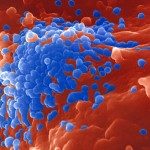Lien vers Pubmed [PMID] – 12639077
Ann. Intern. Med. 2003 Mar;138(6):453-9
BACKGROUND: Anal cancer and its precursor lesion, anal squamous intraepithelial lesions (SILs), are associated with human papillomavirus (HPV) infection. Anal HPV infection and anal SIL are common in HIV-positive men who have sex with men; receptive anal intercourse is presumed to be the mode of acquisition of HPV.
OBJECTIVE: To assess the prevalence and risk factors for anal HPV infection and anal SIL in HIV-positive men with no history of anal intercourse.
DESIGN: Cross-sectional study.
SETTING: Hôpital Européen Georges Pompidou outpatient clinic, Paris, France.
PATIENTS: 118 HIV-infected men.
MEASUREMENTS: 50 HIV-positive heterosexual male injection drug users with no history of anal intercourse and 67 HIV-infected men who had sex with men were evaluated by using anal cytologic, anal histologic, and anal HPV DNA testing.
RESULTS: 23 of the 50 heterosexual injection drug users (46%) had anal HPV infection. Low-grade SIL (LSIL) was found in 8 patients (16%) and high-grade SIL (HSIL) in 9 patients (18%). Among the 67 men who had sex with men, anal HPV infection was found in 57 patients (85%), LSIL in 33 patients (49%), and HSIL in 12 patients (18%). In univariate analysis, risk factors for abnormal anal cytologic or histologic findings in injection drug users included CD4+ cell counts less than 250 x 10(6) cells/L (odds ratio, 5.7 [95% CI, 1.6 to 20.4]), plasma HIV RNA viral load greater than 1.7 log copies/mL (odds ratio, 8.9 [CI, 1.1 to 76.0]), previous AIDS-defining event (odds ratio, 4.3 [CI, 1.2 to 15.6]), and anal HPV detection (odds ratio, 5.7 [CI, 1.6 to 20.4]). Risk factors among men who had sex with men included having more than 10 lifetime receptive anal intercourse episodes (odds ratio, 5.6 [CI, 1.6 to 19.8]) and anal HPV detection (odds ratio, 8.7 [CI, 1.9 to 39.0]).
CONCLUSIONS: Anal HPV infection and anal SIL may be acquired in the absence of anal intercourse in HIV-positive men. The prevalence of HSIL is high among HIV-positive injection drug users. All HIV-positive men with CD4+ cell counts less than 500 x 10(6) cells/L, regardless of history of anal intercourse, should be considered for anal cytologic screening; however, additional studies are needed to determine the efficacy of this procedure to prevent anal cancer in these populations.

